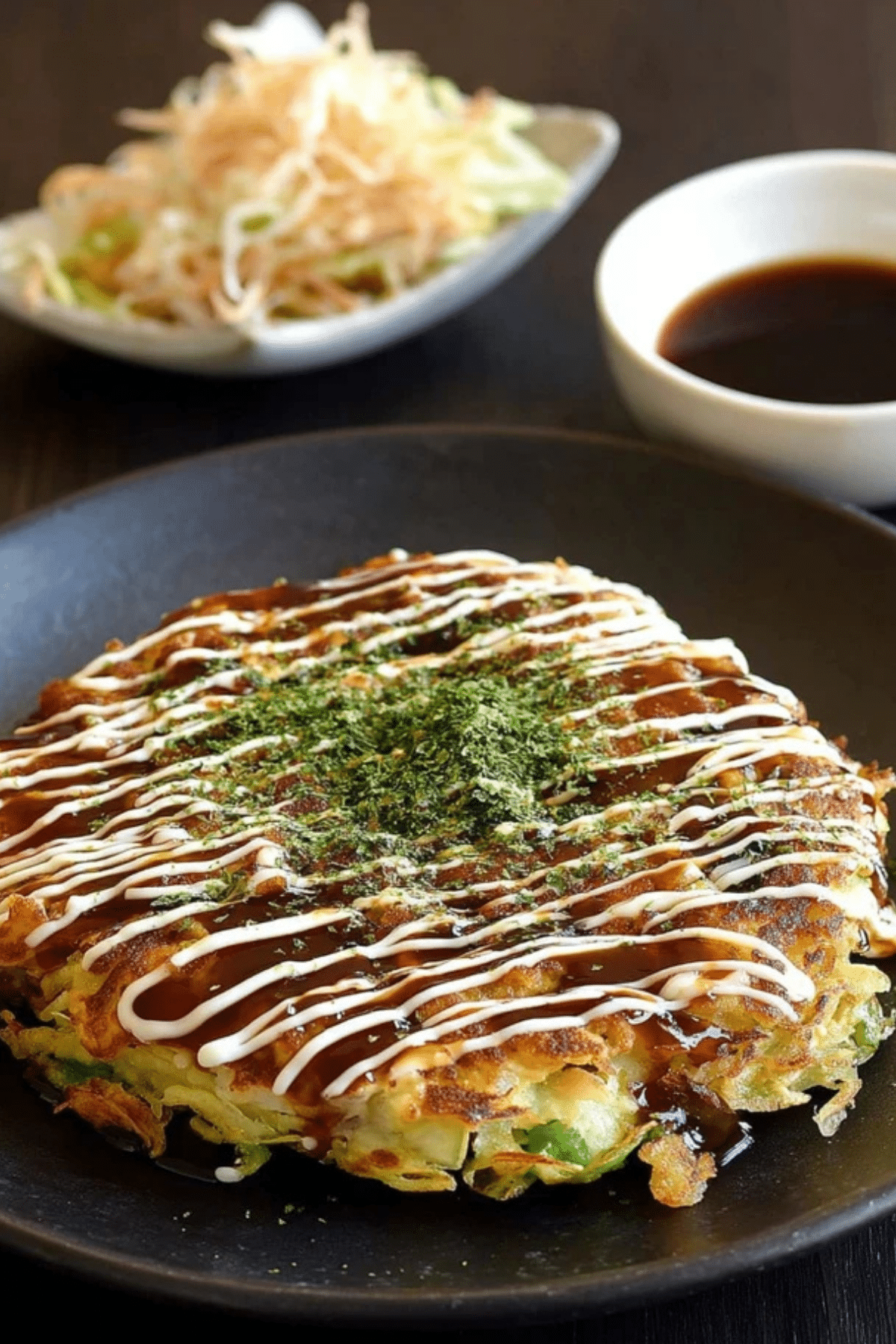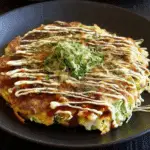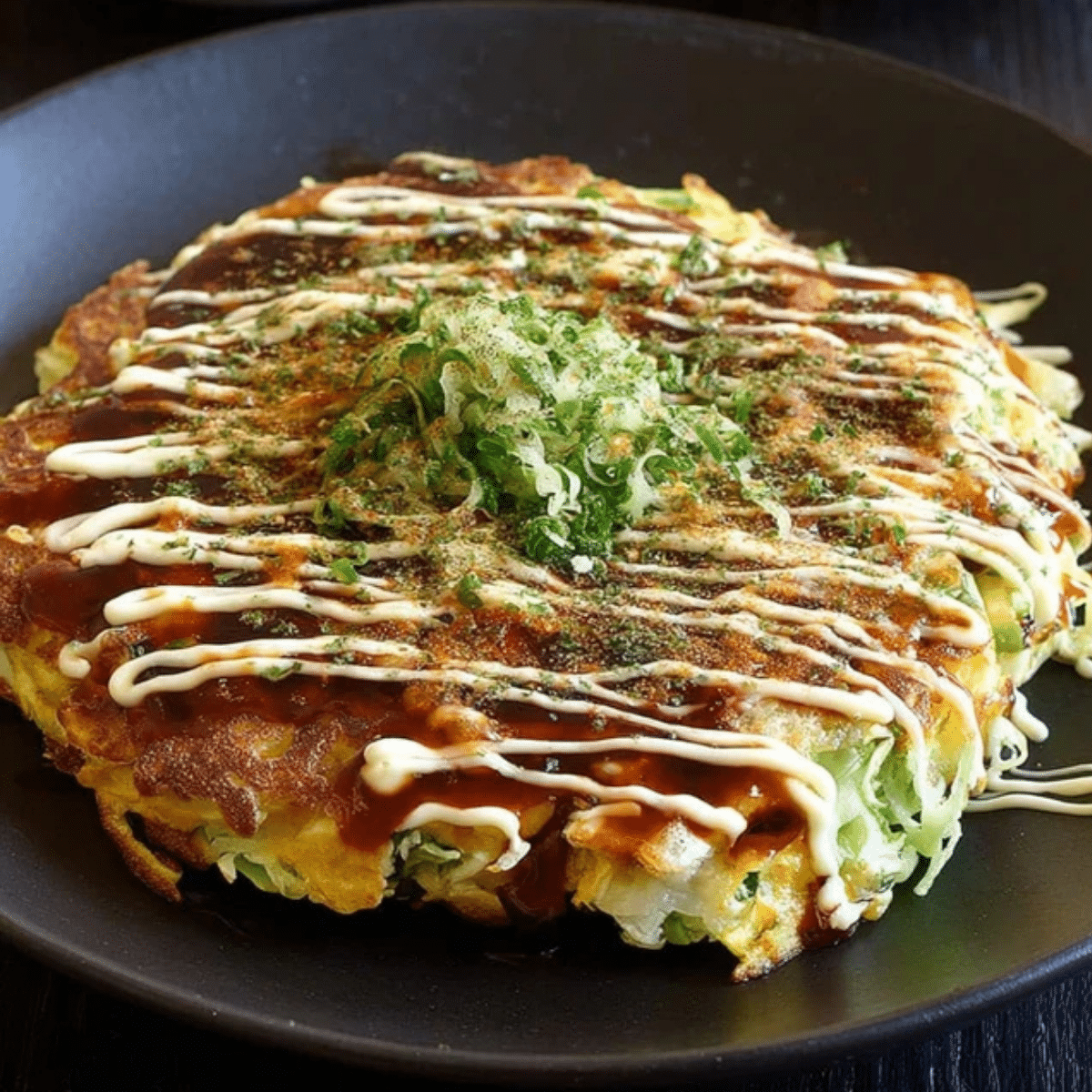Craving a crispy, fluffy, flavor-packed Japanese street food you can whip up in under 30 minutes? This Okonomiyaki recipe is your answer. Known as a “Japanese savoury pancake,” Okonomiyaki is incredibly versatile, deeply satisfying, and packed with umami. Whether you’re looking for a new weeknight dinner idea, a fun meal to make with friends, or a unique twist on pancakes, this dish delivers on all fronts. With cabbage, batter, and bold toppings like Japanese mayo and bonito flakes, this Okonomiyaki recipe will become your go-to comfort food.
Table of Contents
Why You’ll Love This Okonomiyaki Recipe
This authentic Okonomiyaki recipe shines because of its adaptability and simplicity. The name Okonomiyaki roughly translates to “grill it as you like,” making it perfect for any taste or dietary preference. It’s:
- Quick to prepare: Ready in just 25–30 minutes from start to finish.
- Pantry-friendly: Uses ingredients you likely already have or can find easily.
- Family-friendly: Kids and adults alike love the crispy edges and fun toppings.
- Customizable: Add proteins like shrimp or pork, or keep it vegetarian.
Perfect for a weeknight dinner or a cozy weekend lunch, Okonomiyaki is a savory sensation that feels both hearty and playful.
Ingredients That Bring It All Together
Each ingredient plays a specific role in building the texture, flavor, and integrity of the pancake. Here’s what you’ll need:
- Plain flour: Forms the base of the batter, giving it structure and crispness.
- Eggs: Help bind the ingredients and add richness.
- Water or dashi stock: Adds moisture; dashi enhances the umami flavor.
- Green cabbage: The star vegetable – gives bulk, texture, and slight sweetness.
- Spring onions: Provide freshness and a mild oniony kick.
- Tenkasu (tempura scraps): Adds crunch and umami depth.
- Thinly sliced pork belly: Adds richness and savory flavor when grilled on top.
- Okonomiyaki sauce: A tangy-sweet glaze that completes the dish.
- Japanese mayonnaise: Creamy and slightly tangy – pairs perfectly with the sauce.
- Bonito flakes: Provide smoky umami and a fun “dancing” effect from the heat.
- Aonori (seaweed flakes): Adds a sea-salty depth and aromatic finish.
- Pickled ginger (optional): Offers a sharp, refreshing contrast.
Smart Ingredient Swaps You Can Try
Running low on some ingredients or need to make this recipe suit your dietary needs? Try these smart swaps:
- Cabbage: Use pre-shredded coleslaw mix for convenience.
- Pork belly: Swap with cooked shrimp, bacon, or even tofu for a vegetarian option.
- Flour: For gluten-free Okonomiyaki, use a gluten-free all-purpose flour blend.
- Dashi: Substitute with chicken or vegetable broth if needed.
- Tenkasu: Crushed rice crackers or even panko breadcrumbs can mimic the crunch.
Okonomiyaki is all about customization, so feel free to experiment with what’s in your fridge.
Step-by-Step Instructions to Cook Perfect Okonomiyaki
Making Okonomiyaki is easier than it looks. Follow these detailed steps for guaranteed success:
- Prepare the batter: In a large mixing bowl, whisk together flour and water or dashi until smooth. Crack in the eggs and mix well until fully combined.
- Add the vegetables and mix-ins: Fold in the shredded cabbage, sliced spring onions, and tenkasu. Stir gently until everything is evenly coated in the batter.
- Heat the pan: Place a large non-stick frying pan or griddle over medium heat and lightly oil it.
- Form the pancakes: Scoop about 1 cup of the mixture into the pan and shape it into a round pancake, about 2 cm thick.
- Add pork slices: Lay a few pieces of thin pork belly on top of the raw batter.
- Cook the first side: Cover with a lid and cook for 5–6 minutes, until the bottom is golden brown and the cabbage has softened.
- Flip carefully: Use two spatulas to gently flip the pancake. Cook uncovered for another 5–6 minutes until the pork is crispy and the inside is cooked through.
- Plate and top: Transfer to a plate and brush with Okonomiyaki sauce. Drizzle Japanese mayo in zigzag patterns. Sprinkle with bonito flakes, aonori, and pickled ginger if using.

Tips & Tricks for Okonomiyaki Success
Master the art of this Japanese savoury pancake with these insider tips:
- Cut the cabbage finely: Thin shreds cook evenly and ensure a light texture.
- Don’t overmix the batter: Stir just enough to combine – overmixing can lead to dense pancakes.
- Use a lid: Trapping steam helps cook the inside thoroughly while keeping the outside crispy.
- Rest the batter: Letting it sit for 5–10 minutes before cooking can enhance texture.
- Double up: Make a double batch and refrigerate or freeze extras for a quick meal later.
Including these tips ensures your Okonomiyaki is consistently crisp on the outside and tender inside.
Creative Toppings and Flavor Variations
Toppings are what make Okonomiyaki so fun and distinct. Here’s how you can mix it up:
- Spicy twist: Add a touch of sriracha to the mayo or sprinkle with shichimi togarashi.
- Seafood style: Incorporate chopped shrimp or squid into the batter.
- Cheesy fusion: Top with shredded cheese before flipping for a gooey interior.
- Vegetarian option: Skip the meat and add mushrooms or extra greens.
- Mini pancakes: Make smaller versions for party appetizers or kid-friendly bites.
Storage and Make-Ahead Instructions
- Fridge: Store cooked pancakes in an airtight container for up to 3 days.
- Freezer: Wrap tightly and freeze for up to a month.
- Reheat: Warm in a frying pan or oven until crispy again – avoid microwaving to maintain texture.
The Cultural Heart and Seasonal Joy of Okonomiyaki
Originating from Osaka and Hiroshima, Okonomiyaki has become a nationwide favorite in Japan. It gained popularity post-WWII as an affordable, filling meal, and remains a nostalgic comfort food. In winter, it’s especially beloved as a hearty, warming dish. It’s also a staple at festivals, where crowds line up for fresh, sizzling pancakes.
Conclusion
Whether you’re a seasoned home cook or just beginning your journey into Japanese cuisine, Okonomiyaki offers a flavorful and flexible canvas that celebrates creativity in the kitchen. Its crispy exterior, tender cabbage-laced interior, and rich umami toppings make it a meal that satisfies every craving — and every guest at the table. With simple ingredients and customizable fillings, this Japanese savoury pancake is a weekly dinner rotation waiting to happen.
So next time you’re craving something comforting, quick, and utterly unique, let Okonomiyaki be your answer. Flip it your way, top it your way — because this pancake is truly as you like it.
Frequently Asked Questions About Okonomiyaki
1. What is the difference between Osaka-style and Hiroshima-style Okonomiyaki?
The key difference lies in the layering. Osaka-style Okonomiyaki (like the one in this recipe) mixes all ingredients into the batter, while Hiroshima-style layers them, often with yakisoba noodles in between. Both are delicious, but Osaka-style is generally quicker and easier to prepare at home.
2. Can I make Okonomiyaki without Japanese mayo or Okonomiyaki sauce?
Absolutely. While those toppings add an iconic flavor, you can swap them out. For the sauce, mix ketchup, Worcestershire sauce, and soy sauce for a close alternative. Regular mayonnaise can substitute Japanese mayo, although it may be less tangy and sweet.
3. Is Okonomiyaki gluten-free?
The traditional recipe uses all-purpose flour, which contains gluten. To make gluten-free Okonomiyaki, substitute with a gluten-free all-purpose flour blend and ensure any sauces used are also gluten-free. Many Asian sauces contain wheat, so always check the label.
4. Can I make Okonomiyaki vegetarian or vegan?
Yes! For a vegetarian version, skip the pork and add mushrooms, tofu, or extra veggies. For a vegan Okonomiyaki, replace the eggs with a flaxseed egg or chickpea flour batter, and use plant-based mayo and toppings. It’s just as satisfying and flavorful.
More Relevant Recipes
- Japanese-Style Spicy Tuna Salad: A flavorful blend of spicy mayo, tuna, and fresh vegetables, this dish offers the same umami depth and customizable flair as Okonomiyaki. It’s perfect for a light, protein-rich lunch or side dish that complements Japanese flavors.
- Spicy Korean Cucumber Salad: Crisp cucumbers and a bold, spicy dressing make this a refreshing contrast to the richness of Okonomiyaki. Ideal as a side, it balances flavor and heat in a way that pairs beautifully with savory pancakes.
- Asian Chicken Crunch Salad: With crunchy veggies, sesame notes, and juicy chicken, this salad mirrors the texture and umami of Okonomiyaki. It’s a great lighter main dish or companion to Japanese street food-style meals.

Okonomiyaki
- Total Time: 25 minutes
- Yield: 2 large pancakes (serves 2–3)
- Diet: Vegetarian
Description
Okonomiyaki is a savory Japanese pancake made with cabbage, eggs, and flour, topped with rich umami sauces like Okonomiyaki sauce and Japanese mayo. This Osaka-style version is quick, customizable, and incredibly satisfying—perfect for a weeknight dinner or fun weekend treat.
Ingredients
- 1 cup plain flour: Provides structure and crispness to the pancake base
- 2 large eggs: Binds the ingredients and adds richness
- 2/3 cup water or dashi stock: Adds moisture and umami flavor
- 2 cups shredded green cabbage: Gives volume, texture, and slight sweetness
- 2 spring onions, sliced: Adds a mild onion flavor and freshness
- 1/4 cup tenkasu (tempura scraps): Contributes crunch and extra umami
- 100g thinly sliced pork belly: Adds rich, savory flavor when grilled on top
- 2 tbsp Okonomiyaki sauce: Sweet-savory glaze that defines the dish
- 1 tbsp Japanese mayonnaise: Creamy, tangy contrast to the sauce
- 1 tbsp bonito flakes: Smoky umami with a visual “dancing” effect
- 1 tsp aonori (seaweed flakes): Aromatic, sea-salty flavor boost
- Pickled ginger (optional): Sharp, refreshing contrast to balance the richness
Instructions
- In a large mixing bowl, whisk together 1 cup of flour and 2/3 cup water or dashi until smooth.
- Add 2 eggs and mix well until fully combined.
- Fold in 2 cups of shredded cabbage, 2 sliced spring onions, and 1/4 cup tenkasu. Stir to coat evenly.
- Heat a large non-stick pan over medium heat and lightly oil it.
- Scoop about 1 cup of the batter mixture into the pan and shape into a round pancake about 2 cm thick.
- Place several slices of pork belly on top of the raw batter.
- Cover and cook for 5–6 minutes, until golden brown underneath.
- Flip the pancake carefully using two spatulas. Cook uncovered for another 5–6 minutes until the pork is crispy and the pancake is cooked through.
- Transfer to a plate. Brush with 2 tbsp Okonomiyaki sauce and drizzle with 1 tbsp Japanese mayo.
- Top with bonito flakes, aonori, and pickled ginger if desired. Serve hot.
Notes
- Use finely shredded cabbage for even cooking and better texture.
- Dashi stock enhances umami, but water works as a substitute.
- Vegetarian option: omit pork and use mushrooms or tofu.
- Store leftovers in the fridge for up to 3 days, or freeze for later.
- Reheat in a pan to maintain crispness—avoid microwaving.
- Prep Time: 10 minutes
- Cook Time: 15 minutes
- Category: Main Course
- Method: Pan-fried
- Cuisine: Japanese
Nutrition
- Serving Size: 1 pancake
- Calories: 420
- Sugar: 5g
- Sodium: 780mg
- Fat: 22g
- Saturated Fat: 6g
- Unsaturated Fat: 13g
- Trans Fat: 0g
- Carbohydrates: 40g
- Fiber: 4g
- Protein: 18g
- Cholesterol: 135mg

